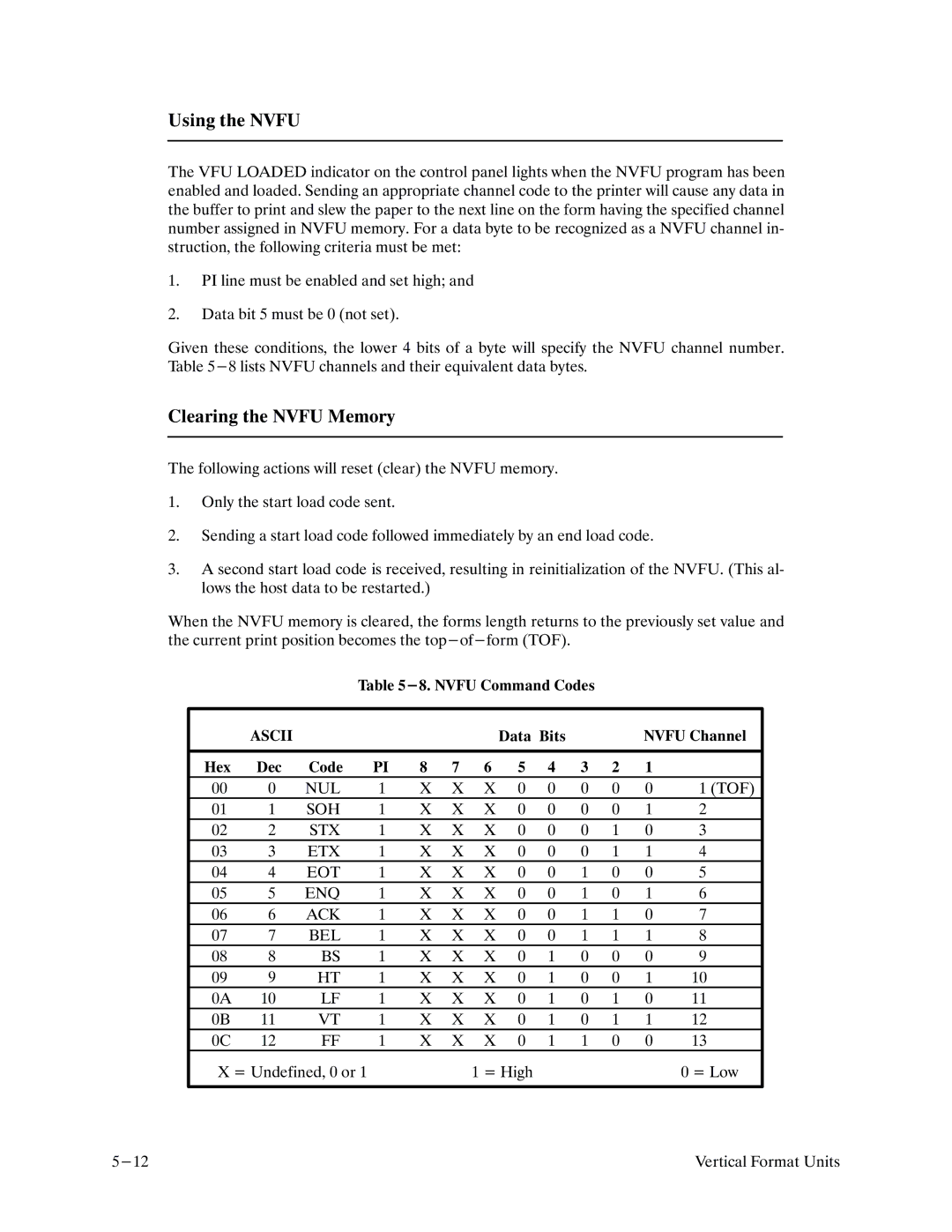
Using the NVFU
The VFU LOADED indicator on the control panel lights when the NVFU program has been enabled and loaded. Sending an appropriate channel code to the printer will cause any data in the buffer to print and slew the paper to the next line on the form having the specified channel number assigned in NVFU memory. For a data byte to be recognized as a NVFU channel inF struction, the following criteria must be met:
1.PI line must be enabled and set high; and
2.Data bit 5 must be 0 (not set).
Given these conditions, the lower 4 bits of a byte will specify the NVFU channel number. Table
Clearing the NVFU Memory
The following actions will reset (clear) the NVFU memory.
1.Only the start load code sent.
2.Sending a start load code followed immediately by an end load code.
3.A second start load code is received, resulting in reinitialization of the NVFU. (This alF lows the host data to be restarted.)
When the NVFU memory is cleared, the forms length returns to the previously set value and the current print position becomes the
Table
| ASCII |
|
|
|
|
| Data Bits |
|
| NVFU Channel | |||
|
|
|
|
|
|
|
|
|
|
|
|
|
|
Hex | Dec | Code | PI | 8 | 7 | 6 | 5 | 4 | 3 | 2 | 1 |
|
|
00 | 0 | NUL | 1 | X | X | X | 0 | 0 | 0 | 0 | 0 | 1 | (TOF) |
01 | 1 | SOH | 1 | X | X | X | 0 | 0 | 0 | 0 | 1 | 2 |
|
02 | 2 | STX | 1 | X | X | X | 0 | 0 | 0 | 1 | 0 | 3 |
|
03 | 3 | ETX | 1 | X | X | X | 0 | 0 | 0 | 1 | 1 | 4 |
|
04 | 4 | EOT | 1 | X | X | X | 0 | 0 | 1 | 0 | 0 | 5 |
|
05 | 5 | ENQ | 1 | X | X | X | 0 | 0 | 1 | 0 | 1 | 6 |
|
06 | 6 | ACK | 1 | X | X | X | 0 | 0 | 1 | 1 | 0 | 7 |
|
07 | 7 | BEL | 1 | X | X | X | 0 | 0 | 1 | 1 | 1 | 8 |
|
08 | 8 | BS | 1 | X | X | X 0 1 0 0 0 | 9 |
| |||||
09 | 9 | HT | 1 | X | X | X 0 1 0 0 1 | 10 |
| |||||
0A | 10 | LF | 1 | X | X | X 0 1 0 1 0 | 11 |
| |||||
0B | 11 | VT | 1 | X | X | X 0 1 0 1 1 | 12 |
| |||||
0C | 12 | FF | 1 | X | X | X 0 1 1 0 0 | 13 |
| |||||
X = Undefined, 0 or 1 |
|
|
| 1 = High |
|
|
|
| 0 = Low | ||||
|
|
|
|
|
|
|
|
|
|
|
|
|
|
Vertical Format Units |
